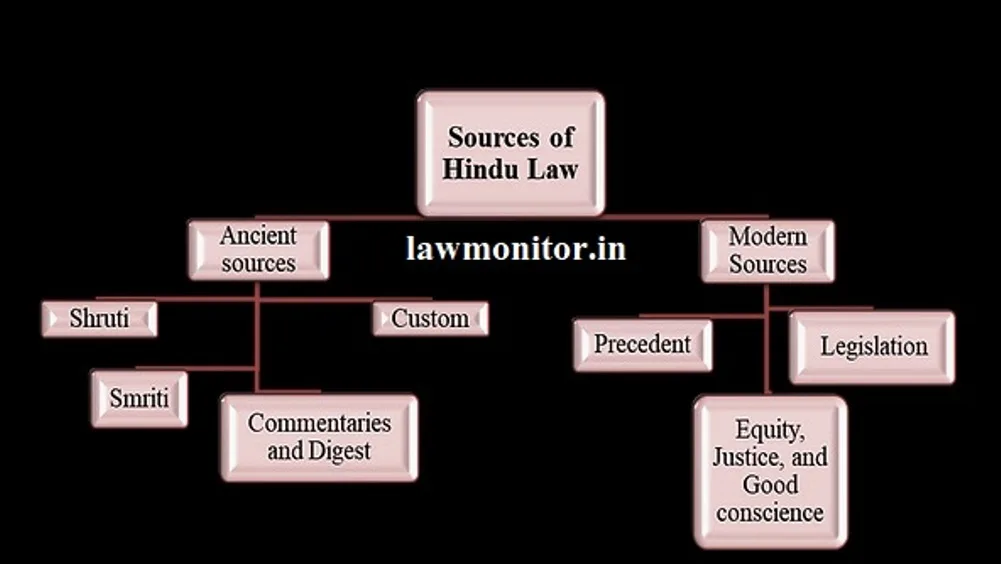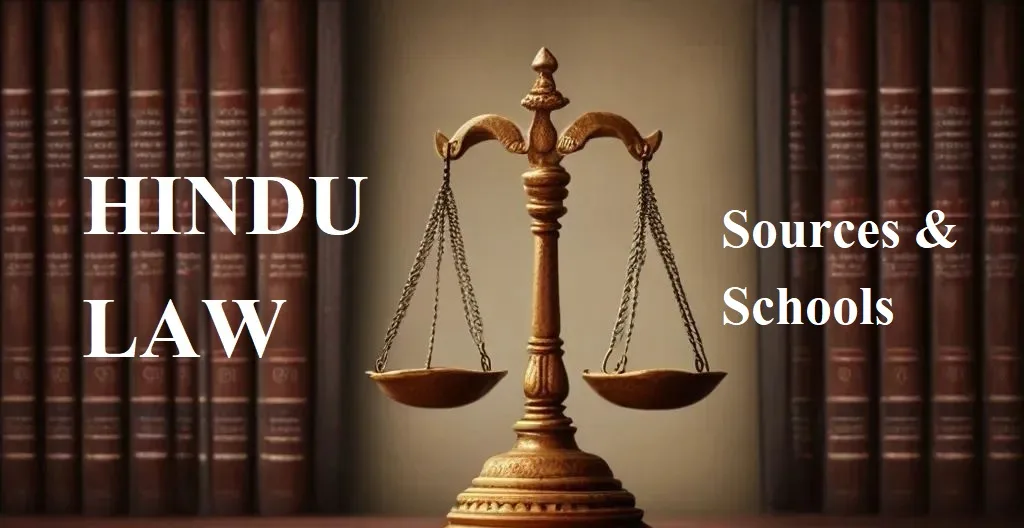Hindu Law Notes: Hindu law stands as one of the oldest and most extensive legal systems globally, with a lineage spanning approximately 6000 years. Initially established to cater to societal needs and ensure the well-being of individuals, Hindu law evolved as a guiding principle for achieving spiritual salvation rather than merely curbing societal wrongs.
The foundations of Hindu law are rooted in divine revelation, believed to have been conveyed to humanity through the Vedas by the divine. These ancient scriptures, comprising the Rig Veda, Yajur Veda, Sama Veda, and Atharva Veda, elucidate principles of life encompassing marriage, succession, adoption, and human relationships.
All through this new age, similar laws have been retrofitted to coordinate current conditions and have been arranged as various demonstrations of which the principal ones are- The Hindu Marriage Act 1955, The Hindu Adoption and Maintenance Act 1956, The Hindu Minority and Guardianship Act 1956, and The Hindu Succession Act 1956.
Sources of Hindu Law

Sources of Hindu law can be broadly classified into:
- Ancient Sources
- Modern sources
A. Ancient Sources
Ancient Sources of Hindu Law The ancient sources of Hindu law can be categorized into four main streams:
- Shrutis: means “what is heard”. These are the primary and supreme sources of Hindu law, believed to be divine revelations heard by sages. While not containing legal rules per se, the Vedas provide fundamental insights into various aspects of human life.
- Smritis: which means “to remember.” Derived from the recollection of the sages, Smritis represent human interpretations and elaborations of Shrutis. Notable Smritis include the Manu Smriti, Yagnavalkya Smriti, and Narada Smriti, which provide guidelines on societal obligations and moral conduct.
- Digests and Commentaries: covered thousand years from 700AD. Spanning over a millennium, these works synthesized and reconciled contradictions within the Smritis. They evolved from explanatory commentaries to comprehensive digests, the last notable one being Nanda Pandit’s commentary on the Vishnu-dharmasutra.
- Custom: Considered (aachara) the highest form of Dharma, custom represents established practices within specific communities or regions.Custom is a mode of conduct, that arises by the practice initiated by the people in the society. Custom is a principal source. Its position is next to Shrutis and Smritis but usage of custom prevails over Smritis. . It holds significant authority and can supersede written laws, with certain criteria defining its validity.
In the case, Laxmibai V. Bhagwanthbuva AIR (2013) SC 1204, the Honourable Supreme Court of India held that custom is an established practice at variance with the general law. A custom varying general law may be a general, local, tribal or family custom.
Laxmibai V. Bhagwanthbuva AIR (2013) SC 1204
Read Also: Administrative Law Notes – Judiciary Notes
B. Modern sources
The Modern sources of Hindu Law can be subdivided into 4 categories— Justice, Equity and Good Conscience, Legislation and Precedent.
- Justice, Equity, and Good Conscience: When legal provisions are absent, courts are obligated to resolve disputes based on fundamental principles of fairness and morality. This approach, often termed as Natural Law, relies on basic values and norms of society to ensure just outcomes. In the absence of specific Hindu law statutes, courts resort to these principles for decision-making.
- For instance, in the case of Gurmukh v. Kamla Bai (1951), the court emphasized the application of Justice, Equity, and Good Conscience when statutory rules were lacking.
- Legislation: Legislative enactments play a pivotal role in shaping modern Hindu law. Historically, during British rule, limited legislation was passed concerning Hindu personal laws, aligning with the policy of non-interference in personal matters. However, post-independence, Acts of Parliament have significantly influenced Hindu law.
- Key statutes include The Hindu Marriage Act (1955), The Hindu Adoptions and Maintenance Act (1956), The Hindu Succession Act (1956), and The Hindu Minority and Guardianship Act (1956). Codification of laws provides clarity and finality on various aspects of Hindu legal practices.
- Precedent: Judicial interpretations and rulings establish precedents, which serve as authoritative sources of law. Through the process of interpretation, existing doctrines and principles may be modified, or entirely new ones introduced, shaping the evolution of Hindu law. Precedents provide guidance and authority for future legal decisions. They ensure consistency and coherence within the legal framework.
One of the gravest cases of the Supreme Court which deserves much criticism is the case of Krishna Singh V. Mathura Ahir (1980) AIR 707. In this case, the Allahabad High Court had rightly held that the discriminatory ban imposed on the Sudras by the Smritis stands abrogated as it contravenes their fundamental rights.
Krishna Singh V. Mathura Ahir (1980) AIR 707
Schools of Hindu Law
Schools of thought within Hindu law reflect diverse perspectives and interpretations, shaping the understanding and application of legal principles. The two primary schools are the Mitakshara School and the Dayabhaga School.
A. Mitakshara School of Thought:
The Mitakshara school derives its name from Vijnanaeshwara’s commentary on the Yajnavalkya smriti, known as ‘Mitakshara.’ This school predominates across India, excluding Assam and Bengal. Despite being a commentary, Mitakshara serves as a comprehensive digest of leading Smritis, covering various titles of Hindu law. Dating back to the 11th and 12th centuries, it emphasizes the Principle of Propinquity, where inheritance is based on blood relationship proximity.
Within the Mitakshara School, there are four prominent sub-schools:
- Dravidian School of Thought: Also known as the Madras School of Thought, it thrives in South India. Notable for its unique customs regarding widow adoption, it requires the consent of sapindas for validity.
- Maharashtra School of Thought: Also called the Bombay School of Thought, it extends to Western India. Renowned works like Vyavakara Mayukha and Nirnaya Sindhu contribute to this school’s body of knowledge.
- Banaras School of Thought: Predominant in Northern India, excluding rural Punjab, it draws authority from texts like the Virmitrodaya and Nirnaya Sindhu.
- Mithila School of Thought: Operating in Tirhut and certain districts of Northern Bihar, it is guided by texts like Vivada Chintamani and Vivada Ratnakara.
Read More: Mitakshara School of Hindu Law- Key Point, Advantages, Criticism,
B. Dayabhaga School of Thought:
The Dayabhaga school is considered to be the dissident school of the Banaras School. Banaras- has been the seal of the Brahmana learning and the citadel of Brahmin orthodoxy and conservatism. Originating in Bengal, it diverges from Brahmin orthodoxy and conservatism, propagating enlightened theories. Founded by Jimutavahana’s Dayabhaga, this school emphasizes spiritual benefit as the basis for inheritance, rather than birthright. It recognizes the inheritance rights of females and prioritizes those who confer greater spiritual merit, as per the Doctrine of Oblations.
This School is prevalent in Assam and Bengal. Kane places the date of composition of Jimutvahana’s literary career from 1090-1130 A.D.
Dayabhaga School posits that sons do not inherently possess birthright to property. In cases of a coparcener dying without issue, his widow is entitled to succeed to his share and enforce partition independently. The females in the family may also inherit the property.
Read More: Dayabhaga School of Hindu Law- Key Point, Advantages, Criticism,
Nature of Hindu Law
Hindu Law is characterized by several defining features, elucidated below.
- Dharma as the Supreme Authority
- The Role of Brahmins in Legislation
- Smritis and Sanskrit Commentaries
- Continuity and Progression
- Application by Courts
Supremacy of Dharma
In Hindu jurisprudence, law transcends mere dictates of authority; it’s an adherence to the supreme moral order, known as “Dharma.” Dharma governs the conduct and obligations of individuals, providing a roadmap towards spiritual fulfillment. Hindu Law underscores the significance of fulfilling one’s rights and duties in harmony with Dharma.
Brahmins’ Role in Legislation
While Hindu Law doesn’t hinge on royal decrees, it acknowledges the pivotal role of Brahmins in legislative matters. Historically, Brahmins wielded paramount influence in Hindu society, exercising legislative authority. Their pronouncements were widely heeded, shaping and elucidating Hindu legal precepts.
Smritis and Sanskrit Commentaries
Hindu Law draws extensively from Smritis, ancient texts delineating personal conduct, societal norms, and legal principles. Sanskrit Commentaries and Digests expound upon these laws, complemented by prevailing customs and traditions.
Continuity and Adaptation
As one of the world’s oldest legal systems, Hindu Law boasts an unbroken lineage marked by continuous evolution. It has adeptly responded to societal transformations while retaining its foundational principles. Even in contemporary times, Hindu Law remains pertinent, its resilience recognized by the Privy Council in the case of Mookka Kone vs Amma Kutti.
Judicial Application
Courts are tasked with interpreting and applying Hindu Law in legal disputes, drawing from Smritis, Sanskrit Commentaries, Digests, and customary practices. Upholding the tenets of Dharma, courts ensure justice is dispensed in consonance with the ethos of Hindu Law.
Short FAQs of Hindu Law
What are the Sources of Hindu Law?
Sources of Hindu law can be broadly classified into: Ancient Sources and Modern sources. Ancient Sources can be categorized into four main streams: Shrutis, Smritis, Digests and Commentaries, Custom. The Modern sources of Hindu Law can be subdivided into 4 categories— Justice, Equity and Good Conscience, Legislation and Precedent.
Types of Schools of Hindu Law
Schools of thought within Hindu law reflect diverse perspectives and interpretations, shaping the understanding and application of legal principles. The two primary schools are the Mitakshara School and the Dayabhaga School.
Nature of Hindu Law
Hindu Law is characterized by several defining features, elucidated below.
- Dharma as the Supreme Authority
- The Role of Brahmins in Legislation
- Smritis and Sanskrit Commentaries
- Continuity and Progression
- Application by Courts



